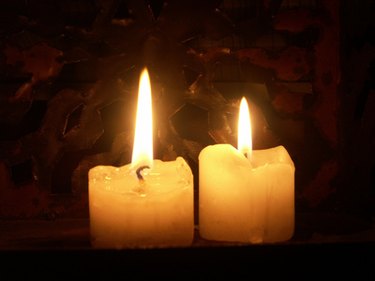
Paraffin wax has no smell and no taste and is generally pale yellow to white and opaque. It is used most frequently in crafting to make candles. The liquid form is mineral oil. Both wax and oil are a petroleum-based hydrocarbon. Paraffin wax comes in various grades; the better grades are more expensive but also have a better melting point.
History of Paraffin
Video of the Day
The Romans were known to melt paraffin wax down and then apply it while still very warm to the body before giving a massage. This relaxed the muscles. French doctors used melted paraffin wax to protect wounds to help them heal and avoid infections. In World War I the British used the wax for orthopedic issues. It was identified by Carl Reichenback in the 1850s.
Video of the Day
How Paraffin Wax is Made
Paraffin wax starts off as a crude oil. The wax is extracted or refined from the mineral oil and then is boiled to become purified. This substance is then cooled and pressed into a filter to make the wax.
Types of Paraffin and Additives
Paraffin wax comes in sheets, blocks, bars and pellets. It comes in several grades with different melting points. Often it is pure but can be mixed with other substances as well. Candle making paraffin is often mixed with stearin to make the candles burn slower and give a gloss to the surface of the candle. Color is often added to paraffin and is either powder or encapsulated by wax and is melted along with the paraffin. Scent is often added to paraffin to make candles smell good.
Paraffin Wax Candles

Paraffin wax is one of the easier waxes to use to make candles. The wax does not stick to the mold and is easy to sculpt. Wax is melted in a double boiler. Melting points are anywhere from 104 to 160 degrees F. Jar candles are made from wax with melting point of about 140 degrees because the wax is still hot and will not hold up well by itself. Molded candles need a melting point of about 145 to 150 degrees.
Pros of Using Paraffin
Paraffin wax is cheaper than other waxes, especially bees wax. It is readily available in all craft stores. It is easy to use even for the beginner candle maker. It is nontoxic and is even put in some foods to make them glossy. It is found most often in chocolate candy but is also found in gum and some recipes call for it.
Cons of Using Paraffin
Paraffin has no scent or color so it has to be added if desired. It burns a little faster than beeswax and the candles made will not last long unless a retardant is added to the paraffin. Paraffin has a flashpoint. If the temperatures go too high the wax could catch on fire. There is some evidence that vapors released when making paraffin from the crude oil can cause cancer.
Warnings

The flash point of paraffin wax is 375 degrees F. Therefore, never leave the wax while it is melting. Also keep the wax away from open flame because it is very flammable. Always use a thermometer to keep track of the temperature. If a fire does start, do not use water to put it out. Cover with a lid or throw baking soda on a small fire. If the fire is larger you must use a dry chemical fire extinguisher.